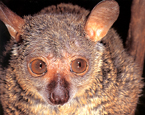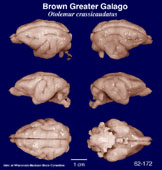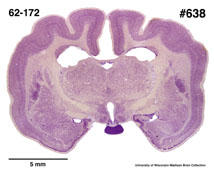|
Brown
Greater Galago
(Otolemur crassicaudatus) #62-172 |
||||
|
|
Physical
characteristics and distribution
|
|
Head
and body length of O. crassicaudatus is 270-465 mm, tail
length is 325-520 mm, and weights range between 600-2,000 grams.
The fur is pale gray tinged with buff or brown, generally darker
around the eyes and the underparts and bushy tail are lighter.
As in Galago, the ears are ridged, allowing the animal to furl
and unfurl them independently from each other. |
|
Description
of the brain
|
|
Animal
source and preparation
|
|
All
specimens collected followed the same preparation
and histological procedure.
|
Other Related Resources (websites and publications)
List of Specimens | Explore Collections | Brain Sections | Brain Evolution | Brain Development | Brain Circuitry | Brain Functions | Location and Use | Related Web Sites | Contact Us | Search MSU Database | Personnel | Home



